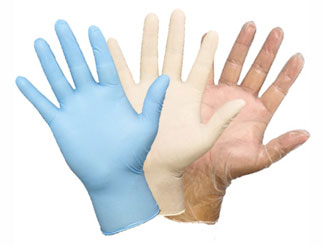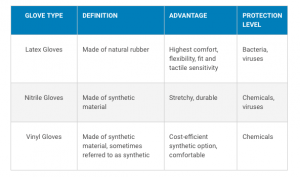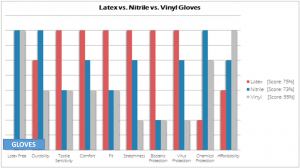GLOVES COMPARISON
Medical gloves are examples of personal protective equipment that are used to protect the wearer and/or the patient from the spread of infection or illness during medical procedures and examinations. Medical gloves are one part of an infection-control strategy. Medical gloves are disposable and include examination gloves, surgical gloves, and medical gloves for handling chemotherapy agents (chemotherapy gloves). These gloves are regulated by the FDA as Class I reserved medical devices that require a 510(k) premarket notification. FDA reviews these devices to ensure that performance criteria such as leak resistance, tear resistance and biocompatibility are met.
When to use medical gloves – Use medical gloves when your hands may touch someone else’s body fluids (such as blood, respiratory secretions, vomit, urine or feces), certain hazardous drugs or some potentially contaminated items.
What you should know before using medical gloves
- Wash your hands before putting on sterile gloves.
- Make sure your gloves fit properly for you to wear them comfortably during all patient care activities.
- Some people are allergic to the natural rubber latex used in some medical gloves. FDA requires manufacturers to identify on the package labeling the materials used to make the gloves. If you or your patient is allergic to natural rubber latex, you should choose gloves made from other synthetic materials (such as polyvinyl chloride (PVC), nitrile, or polyurethane).
- Be aware that sharp objects can puncture medical gloves.
- Always change your gloves if they rip or tear.
- After removing gloves, wash your hands thoroughly with soap and water or alcohol-based hand rub.
- Never reuse medical gloves.
- Never wash or disinfect medical gloves.
- Never share medical gloves with other users.
On December 19, 2016, the FDA published a final rule banning powdered gloves based on the unreasonable and substantial risk of illness or injury to individuals exposed to the powdered gloves. The risks to both patients and health care providers when internal body tissue is exposed to the powder include severe airway inflammation and hypersensitivity reactions. Powder particles may also trigger the body’s immune response, causing tissue to form around the particles (granulomas) or scar tissue formation (adhesions) which can lead to surgical complications. For a detailed description of the risks that the FDA identified, please refer to the final rule.
Additional Information
- Medical Glove Guidance Manual – Guidance for Industry and FDA Staff (PDF – 771KB)
- FDA Consumer Update: Don’t be Misled by “Latex Free” Claims
- Medical Device Bans
- Final Rule: Banned Devices: Powdered Surgeon’s Gloves, Powdered Patient Examination Gloves, and Absorbable Powder for Lubricating a Surgeon’s Glove
Medical gloves help prevent cross-contamination between patients and their caregivers, as well as provide protection against dangerous chemicals and bacteria. For maximum protection, it is important to both choose the right gloves and use them properly.
Standards For Gloves
- ASTM D6319-19 Standard Specification for Nitrile Examination Gloves for Medical Application
- ASTM D3578-19 Standard Specification for Rubber Examination Gloves
- ASTM D5250-19 Standard Specification for Poly(vinyl chloride) Gloves for Medical Application
- ASTM D6977-19 Standard Specification for Polychloroprene Examination Gloves for Medical Application
- ASTM D412 Standard test methods for vulcanized rubber.
- ASTM D573 – Standard test method for deterioration of rubber in air oven.
- ASTM D5161 – Standard test method for detection of holes in medical gloves.
- ASTM D6124 – Standard test method for detection of residual powder on glove.
- EN 455 – Part 1,2,3,4 – EN 455 is one of the most important EN Standards, regulating single use medical work gloves.
- EN 1186 – EN 1186 is the European standard that needs to be passed for a glove, or any other piece of equipment, to be able to safely come into contact with food.
- EN 13130 – Materials and articles in contact with foodstuffs.
- EN/TS 14234- Materials and articles in contact with food stuffs, polymeric coatings on paper and board.
Regulatory Compliances For Gloves
- Australian Register of Therapeutic Goods (ARTG).
- FDA 510 k
- Directive MDD 93/42/EEC of the European Union (EU) (also known as the Medical Devices Directive – MDD) The Medical Device Directive is intended to harmonise the laws relating to medical devices within the European Union. The MD Directive is a ‘New Approach’ Directive and consequently in order for a manufacturer to legally place a medical device on the European market the requirements of the MD Directive have to be met.
- REACH – Registration, Evaluation, Authorisation and Restriction of Chemicals is a European Union regulation dating from 18 December 2006. REACH addresses the production and use of chemical substances, and their potential impacts on both human health and the environment.
- EC 10 2011 – Commission Regulation (EU) No 10/2011 of 14 January 2011 on plastic materials and articles intended to come into contact with food Text with EEA relevance.
- EC 1935 / 2004 – Regulation (EC) No 1935/2004. Full text. It is EU’s framework regulation and sets out general requirements for all food contact materials (FCMs)
How to Choose – When buying disposable gloves, there are many different options available to suit different needs. The level of protection, comfort, durability and more all vary between the types of gloves, which include latex gloves, nitrile gloves and vinyl gloves. With so many choices, the decision can get overwhelming, so let’s break it down and get an idea of why there are so many different types, to begin with. Once you understand this, the process of choosing gloves will be much easier.

Glove Types – Medical gloves are usually made from polymers such as latex, vinyl and nitrile, although you may find disposable gloves made of other materials, such as neoprene. The following is a quick comparison of nitrile vs. latex vs. vinyl gloves, including the differences in design and their unique benefits.

Latex Gloves vs. Latex-free Gloves
Latex gloves are often preferred by healthcare providers since they provide the best service when it comes to elasticity, comfort and fit. Surgeons in particular benefit from latex gloves since they are great for sensitive work, since they offer more precision with high tactile sensitivity. Despite its advantages, latex gloves have become an issue for many health professionals due to the increasing rate of latex allergies, and many are choosing to go with non-latex glove options such as vinyl and nitrile gloves instead. Vinyl gloves, which are made from PVC (polyvinyl chloride), are usually the cheapest latex-free gloves. However, many prefer to use higher-end gloves such as nitrile gloves. Nitrile gloves are often preferred since these non-latex gloves best resemble the stretchy feel of latex gloves, and are also highly durable and puncture resistant. Another difference to consider when deciding between latex and latex-free gloves is the protection offered by each type of material. In general, latex gloves offer the best protection against bacteria and viruses, while synthetic gloves provide better chemical protection. Of the different types of latex-free gloves, nitrile gloves offer a higher degree of protection against viruses, besides the chemical protection they provide.

Glove Options – Now that we have a better understanding of the different materials of disposable gloves and their individual advantages, let’s explore the more specific options available. Each one of these options is intended to provide specific benefits for different uses. In order to choose the right glove type for the intended use, it’s important to understand what these advantages are.

Powdered Gloves vs. Powder-free Gloves – Powder-free gloves can be more expensive due to the process that needs to be done to remove the powder coating from the glove. However, gloves that are powder-free reduce the cause of allergies by lowering protein and chemical content. In addition, powder-free gloves are ‘cleaner’ to use than powdered gloves, since they don’t leave any residue on clothing or other surfaces. Powdered gloves are usually lubricated with cornstarch, which makes them much easier to put on. Cornstarch coatings have replaced other powdering options such as lycopodium powder and talc because these other coating types have been found to irritate tissue. Nevertheless, even cornstarch can impede healing when coming into contact with tissues, so powder-free gloves are often preferred for surgeries and other sensitive procedures.
Chlorinated Gloves vs. Non-chlorinated Gloves
If you choose to use gloves that are powder-free, you’ll need to decide if you want to use chlorinated or non-chlorinated gloves. For those who don’t want to use powdered gloves but want the advantages that come with that type of glove, chlorinated gloves are powder-free gloves that are treated with chlorine to make them easy to put on. These gloves are also particle free to avoid allergic reactions caused by soluble proteins. Chlorinated gloves are more commonly used than non-chlorinated gloves, although some prefer gloves that have a more neutral color and less of an odor. Another disadvantage of chlorinated gloves is their shorter shelf life: after about a year, chlorinated gloves become brittle, and when exposed to heat, these gloves may last even less than a year. Non-chlorinated gloves, on the other hand, are closer in color to regular exam gloves and contain no chlorine odor. However, these gloves are not very popular since they are hard to put on, and are not particle free, since a ‘gel coat’ of tiny gel/silicone particles is added to make them slightly easier to don.
Examination Gloves vs. Surgical Gloves
Both surgical and exam gloves are medical-grade gloves for use during medical procedures. Medical exam gloves can be used for patient examinations and blood tests. These gloves are also used as general purpose gloves for managing incontinence, everyday spills and messes in and around the home. Surgical gloves are used by surgeons and operating room nurses. These disposable gloves must meet higher quality standards, and are usually sterile since they are used for surgical procedures. Surgical gloves offer better fit with more precise sizing, as well as higher tactile sensitivity.
Other Options
Chemo gloves are medical gloves that have been tested for use with chemotherapy drugs. When selecting chemo tested gloves, care must be taken to ensure that the gloves have been tested for the specific drugs being used. Some options that care for the caregiver include gloves with aloe or oatmeal. Gloves with a heat-activated aloe coating soothe and moisturize hands during use. Hardworking hands can also benefit from the extra care provided by gloves that contain colloidal oatmeal skin protectants, which helps maintain the skin’s moisture barrier, thereby preventing and protecting dry skin. In addition to the options listed above, there are other considerations when buying gloves. For example, different gloves are made with different finishes. Some gloves have a smooth finish, while others are partially or fully textured to provide better grip. Another consideration is the type of cuff the glove has. Most gloves are beaded for easier removal, and some gloves have an extended cuff for better coverage and protection.
How to Use – When used and removed properly, disposable gloves offer excellent protection against contamination. Follow the instructions below to get the most out of glove-wearing.
Step 1: Choose – Choose a glove that fits well and is designed for the intended use.
Step 2: Check – Check each glove for rips and punctures.
Step 3: Wash – Gloves should never replace proper hand-washing. Always wash and dry hands before putting on a pair of gloves.
Step 4: Wear – Put gloves on. While wearing disposable gloves, do not touch phones, doorknobs or the like.
Step 5: Remove – Never wash or reuse disposable gloves. In any of the following situations, be sure to remove gloves, wash and dry hands and don a fresh pair of gloves:
- ⇒ Between patients or tasks
- ⇒ When gloves become contaminated
- ⇒ When gloves become dirty
- ⇒ When gloves get torn
- ⇒ When gloves have been used for four consecutive hours
- ⇒ After sneezing, coughing, or touching one’s hair or face
When removing gloves, it is important to follow proper glove removal techniques such as the one shown below to avoid contamination from the outside of the gloves.
Tips
Double Gloving – Double-gloving, or wearing two layers of gloves, is known to provide significantly better protection against inner glove perforation, which lowers the risk of infection that can be caused by punctures or penetration.
At Work – If you own a nursing home, day care center or clinic, you can encourage employees to wear gloves consistently by providing a full range of sizes so all staff members can find a comfortable fit, as well as having enough dispensers throughout your facility so that a new pair of gloves is always accessible.
